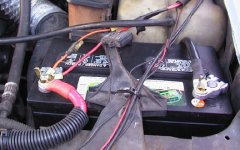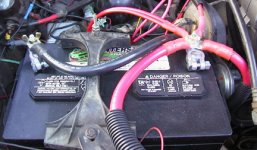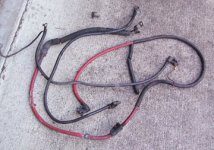jinman
Rest in Peace
- Joined
- Feb 23, 2001
- Messages
- 20,387
- Location
- Texas - Wise County - Sunset
- Tractor
- NHTC45D, NH LB75B, Ford Jubilee
Alan, the best way to prepare the solder joint is to apply solder separately to the cup (crimp connection) and then to the wire. In the parlance of soldering, this is called "tinning the cup and the wire." This ensures that your solder will wet the wire thoroughly and and the cup so that you will not have a cold solder joint. After you have both pieces heated enough to wet, the third operation is simply heating both the wire and the cup to the point that the solder melts and put the two together.
Electrical solder melts at 360 degrees, but that is not hot enough to cause wetting of the solder to the copper. In the case of copper wire, wetting will occur at 510 to 525 degrees if there is no oxidation of the wire. Wetting is the process where the solder actually dissolves the surface of the copper to form a permanent mixture of metals. It's like putting a candy sucker into a glass of water. The surface of the sucker doesn't melt, but it dissolves and the water and candy mix. The copper has to be at over 500 degrees for the solder to melt, flow, and wet the strands of wire.
The common way to pretin small copper wires in electronic manufacturing is to use a solder pot. This is a pot of solder that is kept at about 550 degrees. The stripped and prepared end of the copper wire is dipped into rosin flux and then dipped for only a short period of time into the solder pot. The flux breaks down the surface tension of the molten solder and keeps the copper from oxidizing. If oxidation forms, the solder cannot come into direct contact with the copper and therefore cannot dissolve if for proper wetting. Oxidation is kinda like leaving the wrapper on the sucker and dipping it into water.
Since you don't have a solder pot, I would suggest heating the end of the wire with flux applied and then touch the tip with solder so that it flows and wicks up into the strands. Do not over apply solder. The perfect amount is just enough to bond all the wires, but leave each strand visible. Before you start heating the wire, try to clean it and twist the strands together so they are as close to original as possible (original meaning how they are inside the insulated wire).
Next, heat the connector and apply solder until it wets. Finally, hold the wire close to the connnector and heat both with the torch until you can see the solder on both is melted. Place them together and remove the heat. You're all done.
As I mentioned before, preparation is the key to success. Clean wire and plenty of flux will help you control oxidation. I would definitely use a torch for this because it will take a huge soldering iron and special technique to produce enough heat to do a proper job. The problem with the torch is that you can overdo the heat and burn off the flux if you don't heat carefully. The proper tool would probably be a soldering iron with a tip the size of your thumb. You probably don't have anything like that. There are some torch kits that have large soldering tips and one of those might work as well. With a tip, the trick is to keep it tinned and form a solder bridge so you get proper heat transfer to your workpiece. Good soldering techniques are not always intuitive. They're learned like good welding technique.
Now, having said all this, in your situation, I might just get the end of the wire as clean as possible and insert it into the cup. Apply flux and heat until you can apply solder and let it flow into the connection. After all, you aren't building airplanes or space ships. It will probably be just fine, but be sure to use enough flux and heat that your joint isn't cold solder.
Electrical solder melts at 360 degrees, but that is not hot enough to cause wetting of the solder to the copper. In the case of copper wire, wetting will occur at 510 to 525 degrees if there is no oxidation of the wire. Wetting is the process where the solder actually dissolves the surface of the copper to form a permanent mixture of metals. It's like putting a candy sucker into a glass of water. The surface of the sucker doesn't melt, but it dissolves and the water and candy mix. The copper has to be at over 500 degrees for the solder to melt, flow, and wet the strands of wire.
The common way to pretin small copper wires in electronic manufacturing is to use a solder pot. This is a pot of solder that is kept at about 550 degrees. The stripped and prepared end of the copper wire is dipped into rosin flux and then dipped for only a short period of time into the solder pot. The flux breaks down the surface tension of the molten solder and keeps the copper from oxidizing. If oxidation forms, the solder cannot come into direct contact with the copper and therefore cannot dissolve if for proper wetting. Oxidation is kinda like leaving the wrapper on the sucker and dipping it into water.
Since you don't have a solder pot, I would suggest heating the end of the wire with flux applied and then touch the tip with solder so that it flows and wicks up into the strands. Do not over apply solder. The perfect amount is just enough to bond all the wires, but leave each strand visible. Before you start heating the wire, try to clean it and twist the strands together so they are as close to original as possible (original meaning how they are inside the insulated wire).
Next, heat the connector and apply solder until it wets. Finally, hold the wire close to the connnector and heat both with the torch until you can see the solder on both is melted. Place them together and remove the heat. You're all done.
As I mentioned before, preparation is the key to success. Clean wire and plenty of flux will help you control oxidation. I would definitely use a torch for this because it will take a huge soldering iron and special technique to produce enough heat to do a proper job. The problem with the torch is that you can overdo the heat and burn off the flux if you don't heat carefully. The proper tool would probably be a soldering iron with a tip the size of your thumb. You probably don't have anything like that. There are some torch kits that have large soldering tips and one of those might work as well. With a tip, the trick is to keep it tinned and form a solder bridge so you get proper heat transfer to your workpiece. Good soldering techniques are not always intuitive. They're learned like good welding technique.
Now, having said all this, in your situation, I might just get the end of the wire as clean as possible and insert it into the cup. Apply flux and heat until you can apply solder and let it flow into the connection. After all, you aren't building airplanes or space ships. It will probably be just fine, but be sure to use enough flux and heat that your joint isn't cold solder.




